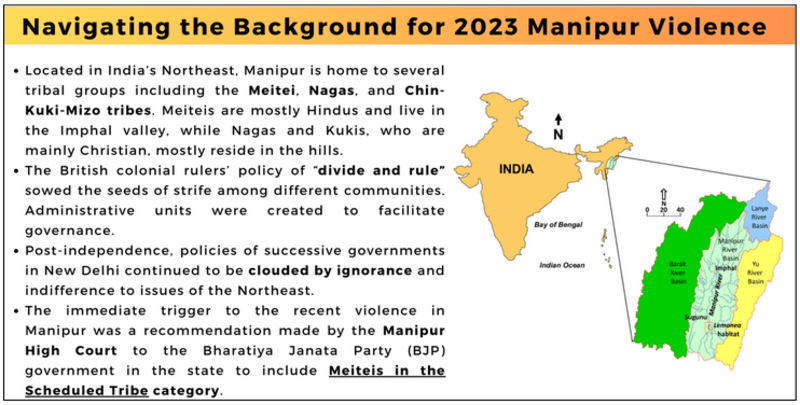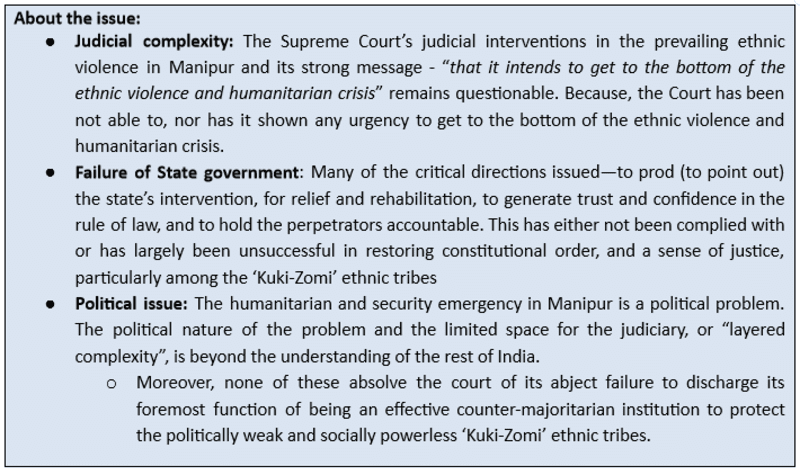A Moral Failure
“National security is the first duty of government but we are also committed to reversing the substantial erosion of civil liberties”. - Theresa May
Relevance: GS II and III (Polity/Governance and Internal Security)
- Prelims: Section 6A of the Citizenship Act 1955; Article 355
- Mains: Federal Issues - Judicial complexities; State accountability;
Why in the News?
The Supreme Court’s failure to enforce state accountability and assess the power imbalances between communities has deepened the humanitarian crisis in Manipur.


How it was a Judicial Failure?
- Failure of the watchful guardian against the violation of rights:
-
- Supreme Court's unwillingness to interrogate and evaluate the high degree of structural asymmetricity in the distribution of political and social power between the two communities is seen as the failure of the watchful guardian against the violation of rights in the following way:
- Firstly, the refusal of the Supreme Court to enforce state accountability for its complicity (through commission or omission) in the heinous crimes against ‘Kuki-Zomi’ ethnic tribals;
- Secondly, its inability to grasp the magnitude of the humanitarian catastrophe that has arisen;
- Thirdly, the failure to acknowledge that the state machinery is acting with prejudice and bias against different sections of the ‘Kuki-Zomi’ ethnic tribes.
- Thus, the responses formulated by the Court have largely proven ineffective and inadequate.
- Supreme Court's unwillingness to interrogate and evaluate the high degree of structural asymmetricity in the distribution of political and social power between the two communities is seen as the failure of the watchful guardian against the violation of rights in the following way:
- Justice was Delayed:
- Due to the wider gaps between the judicial hearings (almost two months), the killings were increased.
- When the petitioners applied to the deployment of the Army, etc., for their protection the Court refused to admit the request based on the rather fallacious reasoning that its intervention may “aggravate” the situation and create “more problems”.
- Shortly after the viral video depicting two tribal women being paraded naked and later gang-raped by a Meitei mob surfaced on social media, the Supreme Court took suo-moto cognizance by directing the investigation of 11 FIRs relating to violence, including sexual violence against women and children.
|
Retd. CJ. Gita Mittal Committee:
|
- The constitutional court platform was used for the constant vilification and demonization:
-
- The Coordinating Committee on Manipur Integrity (COCOMI), an umbrella body of Meitei CSOs had in a mass public gathering, demanded the implementation of a National Register of Citizens in Manipur (echoing a resolution adopted by the Manipur Legislative Assembly in 2022).
- Secondly, regarding the constitutional challenge to Section 6A of the Citizenship Act, being heard by the Supreme Court, the fear is writ large that the ultimate intent of perpetuating falsehoods before the Supreme Court may be to force the Court to judicialize the rhetoric of “large scale illegal migration”.
- Dehumanizing tendency: The way the Court declared immigration to be an “external aggression” premised on Article 355, and by deception laid the foundations for the dehumanizing NRC process in Assam through its judgments in Sarbananda Sonowal I and II.
|
How it was the failure of Government/State machinery?
- False claims of normalcy:
- The State government in a statement before the Court submitted that there had been no violence reported. This was particularly surprising given that at least seven Kuki-Zomi tribals were reportedly killed.
- This being the case, the Court should have probed the State on its tall claims of normalcy. Unfortunately, it did not. When the directions for relief, rehabilitation, and security were welcome, the bloodiest wave of the targeted killings had already been executed.
- Almost all the Kuki-Zomi legislators had their homes attacked and were forced to flee Imphal, with one of their colleagues almost bludgeoned to death. This hampered their ‘Right to Speech’.
- Low swiftness in investigation: If the CBI could not act with swiftness in the investigation of the killing of David Thiek/Tuolor, whose head was decapitated in Langza village in July, put up for display on a bamboo fence, and graphic videos/images of the same circulated on social media.
- Unanswered questions: The petitioner (Zomi Students’ Federation) had suggested that steps be taken to:
-
- Transfer of displaced ‘Zo’ medical students of JNIMS and RIMS (Imphal), to other institutions outside Manipur.
- Begin the process of identification and handover of the dead bodies lying in mortuaries across Imphal to the next-of-kin. In this regard, even as the Court’s specific directions remained without implementation.
- Violation of Human Rights:
- Firstly, a complete denial of education through the loss of critical learning days for approximately 7 months.
- Secondly, the bodies of deceased persons would have likely been decomposed beyond recognition. Indeed, the next-of-kin of deceased persons have refused to claim the bodies based on “pressures” exercised by the tribal CSOs to conduct a mass burial, purportedly responsible for “keeping the pot boiling”.
Conclusion: The humanitarian and security emergency in Manipur requires political will to carefully design and decisively deliver an enduring set of political solutions.
Mains PYQs
Q. We are witnessing increasing instances of sexual violence against women in the country. Despite existing legal provisions against it, the number of such incidences is on the rise. Suggest some innovative measures to tackle this menace. (2014)
Q. Mob violence is emerging as a serious law and order problem in India. By giving suitable examples, analyze the causes and consequences of such violence. (2017)
Q. Analyze the complexity and intensity of terrorism, its causes, linkages and obnoxious nexus. Also suggest measures required to be taken to eradicate the menace of terrorism. (2021)

